2018 Rolls-Royce Phantom review, test drive
The Phantom is back after a long time in a new high-tech avatar and it oozes even more premiumness.
Published on Oct 16, 2017 03:23:00 PM
57,210 Views
Follow us on



What is it?
Meet the eighth generation of the Rolls-Royce Phantom which comes 14 years after the previous one to, once again, stake claim to the ‘world’s best car’ title. That it has come after so long makes the arrival of the Rolls-Royce’s flagship an even more momentous occasion, like the coronation of a new king and with it, the continuity of a royal bloodline.
If there is any car that can claim to be the king of the car world, it’s the Phantom. It has been around since 1925 and is the longest running nameplate on a car ever. But what has really distinguished this Rolls-Royce model over eight generations and 92 years is that it has stood to represent the pinnacle of automotive luxury. “A Phantom is a Phantom is a Phantom,” said Rolls-Royce CEO, Torsten Müller-Ötvös, to drive home the point that it’s the ultimate benchmark and there’s nothing quite like it. In fact, Rolls-Royce likes to refer to the Phantom as a ‘luxury good’ that many of its super-rich owners would buy, just like a yacht or a private jet, to indulge their lifestyles.
To make the world’s best car even better was never an easy task for the engineers, but with the new Phantom, they were given a great starting point – an all-new aluminium spaceframe that makes its debut in the latest Rolls. In fact, this new platform will underpin future Rolls-Royce models including Project Cullinan, which is the internal name for first ever Rolls-Royce SUV.
Rolls-Royce engineers opted for an aluminium chassis not because it’s lightweight but mainly for its superior torsional rigidity which is a good 30 percent more than the outgoing Phantom. A stiffer chassis is good for refinement and ride quality, which are key attributes that define a Rolls-Royce. However, to really smother the road and deliver the famed Rolls-Royce ‘magic carpet’ ride, engineers had to conjure their own magic on the suspension and tyres. The mighty Phantom rides on air springs, which come with only one setting and can’t be manually adjusted. But, forward-facing cameras read the road surface and signal the suspension to alter its stiffness accordingly. Pretty high-tech for a Rolls, isn’t it? But it’s with the tyres that Rolls-Royce has gone the extra mile to eke out that last bit of ride comfort.

The importance of tyres can never be underestimated and is the suspension’s first line of defence, especially over ridges, sharp edges and ruts, where the tyre sidewall is responsible for the crucial ‘secondary’ ride comfort. Rolls-Royce has ditched run-flat tyres because their stiff sidewalls hurt ride quality, so instead, the massive 22-inch rubber on our test car came with soft sidewalls, which greatly benefit low-speed ride, especially on broken services. The down side is that directional stability and handling does suffer, but to compensate, the Phantom now gets electronic stabilisers to keep any on-road waywardness in check. The tyres also get a layer of sound-deadening foam that lines the inner walls to muffle tyre noise. Is that a bit of overkill? Not if you consider the 6mm of double-glazed glass all around and 130kg of sound deadening material stuffed throughout the car, in the quest to make the Phantom the quietest car in the world.
The Phantom also gets four-wheel steering or rear wheels that steer in the opposite direction by three degrees to make manoeuvring for you and your chauffer that much easier. The Phantom has a turning circle diameter of 13.7m for the extended version, which is pretty damn good for a car with a 3,772mm-long wheelbase.
Under the Phantom’s long hood is a 6.75-litre V12 engine again, but apart from sharing the same displacement and cylinder configuration, it’s completely different to the one in the previous Phantom and is more of a reworked version of the Ghost’s 6.6-litre V12. Its power output of 555hp is similar to that of the outgoing car but twin turbochargers (a first on a Phantom) boost torque to a colossal 900Nm, which is developed from as little as 1,700rpm. Boosting torque was given priority to enhance the ‘waftiness’ of the Phantom, which is the core of a Rolls-Royce’s majestic character.
And majestic is what the new Phantom still looks despite a few modern elements that have been introduced in the design. The signature ‘Parthenon’ grille doesn’t sit quite as proudly on the nose as before and is now flush with the body and a bit canted rearwards too. “There’s a reason for this,” lets on Philip Koehn, director of engineering. “In the previous Phantom, the front grille caused a bit of turbulence which hit the middle windscreen but in the new car we’ve deflected the turbulent airflow above the body” he says. This is further proof that, when it comes to refinement, Rolls-Royce is unflinchingly uncompromising.
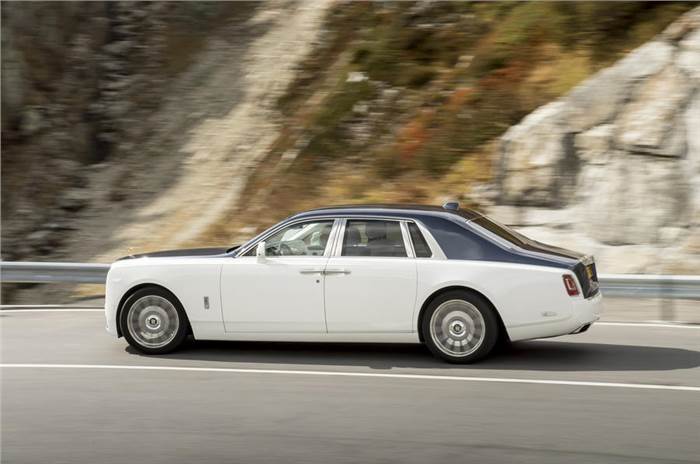
The new Phantom has a more square-jawed look, with the angular fender jutting out at the front. The body surfacing is cleaner now and the centre crease running down the bonnet and the prominent shoulder lines of the previous model have now been smoothened out. Sunken into the bodywork are slim and wide headlights – surrounded by an LED strip and featuring laser high beams – that look pretty high-tech in what is a very traditional shape.
All the body panels are new but the untrained eye will have trouble telling the new Phantom apart from the previous model. Rolls-Royce hasn’t deviated from the previous car’s styling intentionally because owners just loved the way the Phantom VII looked. The overall road presence of the new Phantom hasn’t diminished and it looks as stately and unabashedly ostentatious as ever.
What’s it like on the inside?
Rolls-Royce’s signature ‘coach doors’ or rear doors hinged at the back, open wide for easy access into a cabin that is truly fit for a king. Seated in the rear, I shut the electrically operated doors with the touch of a button (the chauffer can do it from the outside as well) to hermetically seal me off from the outside world.
You can spend the whole day inside a Phantom just soaking up the unadulterated luxury oozing out of every pore. There’s richness in every small detail; right from the deep-pile carpets, the exquisitely stitched leather trim and fine-grain wood, to the soft leather seats with the feather-filled headrests. Seat comfort is something you won’t complain about even in the standard-wheelbase Phantom, which has an abundance of legroom, while the extended version has an excess of it to the point that I can sit with my legs fully stretched-out. You sit nice and high in the sumptuous rear seats, which can be amply reclined. The sofa-like seats will heat or cool your backside and even massage you. This latter function is what I discovered accidentally and in the process also exposed a minor design flaw.
My knee would knock a button on the switch panel on the door, which inadvertently activated the massage function. This kept happening a couple of times which made me wonder why the cluster of switches couldn’t have been moved forward. Koehn has received this feedback and is well aware that the switch placement, directly in line with a passenger’s knee, is not optimal but says. “Moving it forward would make passengers stretch to reach them.” And that’s when you realise how much thought has gone into making the switchgear fall easily to hand. You don’t have to stretch or bend to reach any of the switches (and crease your suit or gown by doing so) but simply sit back, close the doors via the button on the C-pillar, and activate the air con, stereo and all the seat functions via the rotary dial cluster in the centre console of the arm rest. Even the small table and individual entertainment screens flip down with press of an easily accessible button. The switches themselves are wonderfully damped, as are the traditional organ-stop plungers that control the air flow. You also get a coolbox complete with a pair of champagne flutes.

Upfront, the seats aren’t as lavish as the back but they are hugely comfortable and come with a wide range of adjustments. For the first time on a Rolls, the front doors too can be electrically closed with the touch of a button, which relieves the front occupants from the undignified task of stretching out for the door handle. The Y-spoke steering wheel is as massive as ever but now comes with a plethora of buttons. Also giving a nod to modernity is the digital instrument cluster, which replace the analogue dials, and a heads-up display for the driver.
The ‘starlight’ roof is a special Rolls-Royce feature that only covered half of the roof in the previous phantom, but now on the new car it runs all the way to back. The extended Phantom has a whopping 1,344 fibre optic lights randomly scattered in the headliner. The electrical architecture allows each of these lights to be individually controlled, allowing Rolls-Royce to give you your own customised constellation! But while Rolls-Royce can promise you the stars, it can’t give you the sun or the moon. There is no sunroof, not even as an option, in the new Phantom.
The real star of the show in the new Phantom, however, is what the Rolls-Royce calls ‘The Gallery’. It’s an incredibly creative idea that allows owners to customise their cars to a different level to make them works of art – literally. A single piece of fixed glass spans the width of the dashboard, covering a blank space that begins from one end of the dashboard and extends behind the retractable screen till the instrument cluster on the driver’s side. Essentially this blank surface acts a canvas for works of art, which owners can commission from their favourite artists or, choose from several unique compositions that Rolls-Royce has already created.
Giving owners the opportunity to have a masterpiece inside their car is a masterstroke, and what Rolls-Royce has ensured by having The Gallery in the new Phantom is that no two cars are the same. You can’t have it more exclusive than this.
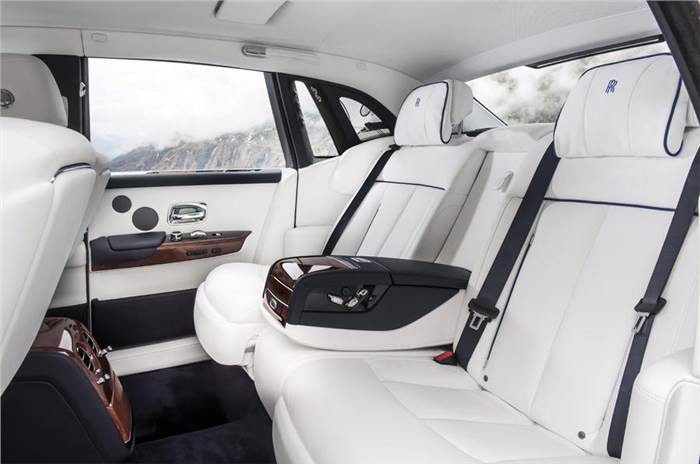
What’s it like to drive… and be driven in?
The place to be in a Phantom is at the back and my experience begins sitting behind the chauffer. It’s an incredible experience being whisked away in a car that just effortlessly glides forward like it’s on a cushion of air. The roads in Switzerland are super smooth and have strictly-enforced speed limits, which only serves to accentuate the Phantom’s utterly relaxed demeanour. The odd, sharp edge we encounter in the form of a railway crossing registers as a distant, muted thud. The new Phantom simply soaks up the road quietly and efficiently, leaving you oblivious of the surface you’re travelling on. The ultra-low noise levels add to the sense of calm. Rolls-Royce wasn’t joking when it said it was making the world’s quietest car even quieter. The big V12 engine is barely audible and there’s hardly any road or wind noise either. The cabin is so eerily silent that you could almost hear a ghost cough.
The softly sprung Phantom, however, does ever so slightly heave up and down. It’s not something most owners may notice but being terribly prone to sea sickness I’m super sensitive to any low-frequency pitching movement. I would have preferred slightly stiffer dampers for a flatter ride but Koehn felt that it would hurt the secondary ride. “We could have made the dampers stiffer to reduce the pitch but then the low-speed ride comfort may have suffered,” he said. There’s no doubt that the Phantom doesn’t like to be rushed and feels best driven in an unhurried way, even though the massive V12 is capable of propelling this 2,610kg car to 100kph in 5.1sec.
I realised that, when I hopped into the front seat to drive the Phantom for the first time, the long-travel throttle pedal and the engine are calibrated to deliver power in a measured way. So when you bury the pedal in the thick carpet, the Phantom picks up momentum like an Airbus thundering down a runaway. There’s a slickness with which the engine and transmission work together to a deliver a creamy wave of torque for the driver to effortlessly surf on. The way the Phantom masks speed made it genuinely impossible not to break the speed limit.
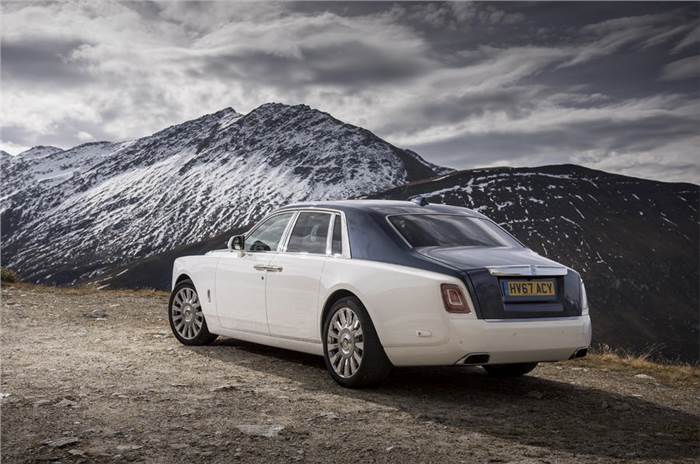
The steering isn’t exactly bristling with feel and there’s a fair bit of play around the straight ahead position; the soft sidewall tyres have clearly compromised the responsiveness of on centre steering wheel. But do owners really care? They don’t want the last word in handling but instead want a car that is easy to drive and one that inspires confidence to be driven at a brisk pace. The Phantom not only delivers well on these fronts but also when is out of its comfort zone.
On the tight and twisty Furka Pass up in the Swiss Alps, the big Phantom showed astonishing agility, flitting deftly from one hairpin to another. It’s easy to place the massive Phantom accurately through corners, and the brakes are superb too. That’s reassuring for owners who want to take their Phantom to their favourite hill station when bad weather has grounded the chopper.
Should I buy one?
That’s a difficult question to answer, especially if the price of a minimally specced Phantom, after paying nearly 200 percent in taxes and duties, is expected to cost Rs 8 crore (on road), rising to around Rs 9.5 -10 crore for a car with a decent amount of customisation. Terms like ‘value for money’ and ‘bang for your buck’ are not part of a Phantom buyer’s lexicon. What they are looking for is the ultimate luxury car and one that they are unashamed to flaunt. The new Phantom also takes customisation and exclusivity to a different level, with its concept of the bespoke Gallery. View the Phantom not just as an automobile but also as a work of art which, with its ludicrously high price tag, might just start making sense, but only if you are a billionaire.
Tech Specs 
Copyright (c) Autocar India. All rights reserved.


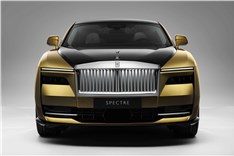
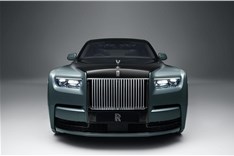



 Engine
Engine Transmission
Transmission Body
Body Dimensions
Dimensions
Comments
Member Login
Personal Details
No comments yet. Be the first to comment.